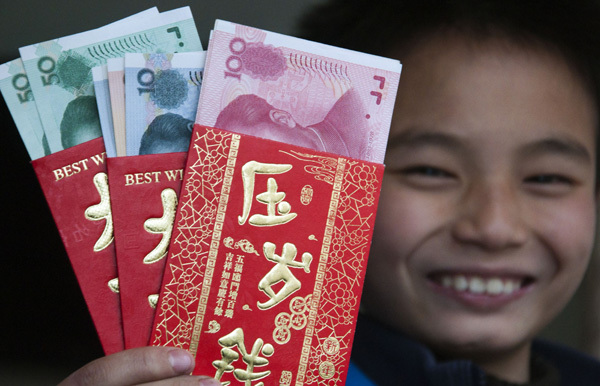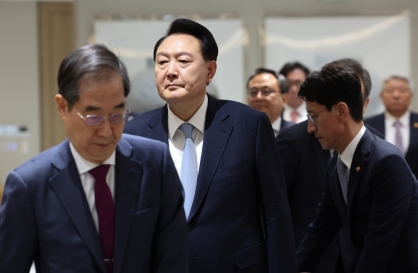
The tradition and true meaning behind the giving of red envelopes to children during Spring Festival is being lost as people stuff them with ridiculously large amounts of cash or use them as a networking tool to cultivate favors in return, experts warn.
The tradition of handing out red envelopes started 2,000 years ago during the Eastern Han Dynasty (A.D. 25-220), aiming to protect children from a monster named Sui that brings misfortune.
They are normally given to children up to their 18th birthday or, in some cases, when they get their first job.
Chen Hewen, 50, owns a wedding company, and tried to dissuade friends and relatives from giving large sums of money to his 12-year-old daughter, who just started middle school.
Despite his efforts, the girl still managed to get more than 7,000 yuan ($1,150), double the amount of last year.
Her father kept his donation to 200 yuan, an amount he has stuck to for seven years.
“I think it’s pointless to give my child that much money,” he said.
“It’s just a huge burden. I have to pay it back to them anyway, one way or another, but they have all sorts of excuses, like the donation has to rise every year, or my daughter just entered middle school. If I hadn’t tried to dissuade them, she could have easily earned more than 10,000 yuan.”
A Beijing News survey this month of 90 primary and middle school students found that the recipients got 438,000 yuan, an average of 4,867 yuan each.
The survey indicated that children whose parents worked in the government or business tended to get more money in the envelopes and from more people.
“It used to be of no real monetary value at all. The red envelopes used to have specially designed coins. It was like that for hundreds of years,” said Wu Xinfeng, a senior member of the Chinese Folklore Society.
“But now people use real money and lots of it, and they are using the envelopes in exchange for favors. The spirit behind the tradition is being twisted.”
A Chinese language teacher at Xizhongjie Primary School in Beijing’s Dongcheng district, who only gave her surname, Xu, has seen a huge growth in the use of the envelopes given to children in the 6-12 age group as well as the cash they contain.
“When I taught my first class three decades ago, there were barely any given. Later in the 1990s, my students were happy with 5 yuan or sometimes 10 yuan,” said Xu. “At the turn of the century, the children might have 100 or 200 yuan, but never beyond 1,000 yuan.”
However, starting from 2008, none of her students would come back to school from winter vacation with less than 1,000 yuan, Xu recalled. “Then, three years ago, I saw my first student with more than 10,000 yuan.”
This year, Xu had a student claiming he received 50,000 yuan.
Of course, this does not apply to all students.
Xiang Pengyu, 13, always receives 2,000 yuan, no more, no less, since the first time he opened an envelope in third grade.
“With the envelope in my hands, I can feel my parents’ love,” Xiang said. “It’s not about the money. It is the thought.”
His father, Xiang Dong, 46, a Sichuan-born chiropractor at Beijing Massage Hospital, is careful about the 2,000 yuan limit.
“We are an ordinary family. With a reasonable amount in the envelope, my son will form a sense of what to expect and what not to. His mother and I will not let him suffer, but we will not overindulge him.”
For that reason, Xiang’s father refused all offers from people outside his family to give money to Xiang.
“I don’t want to waste time and money sending it back and forth,” he said.
As a result, Xiang only gets the lucky money from his parents and four relatives.
By Chen Mengwei
(China Daily)
The tradition of handing out red envelopes started 2,000 years ago during the Eastern Han Dynasty (A.D. 25-220), aiming to protect children from a monster named Sui that brings misfortune.
They are normally given to children up to their 18th birthday or, in some cases, when they get their first job.
Chen Hewen, 50, owns a wedding company, and tried to dissuade friends and relatives from giving large sums of money to his 12-year-old daughter, who just started middle school.
Despite his efforts, the girl still managed to get more than 7,000 yuan ($1,150), double the amount of last year.
Her father kept his donation to 200 yuan, an amount he has stuck to for seven years.
“I think it’s pointless to give my child that much money,” he said.
“It’s just a huge burden. I have to pay it back to them anyway, one way or another, but they have all sorts of excuses, like the donation has to rise every year, or my daughter just entered middle school. If I hadn’t tried to dissuade them, she could have easily earned more than 10,000 yuan.”
A Beijing News survey this month of 90 primary and middle school students found that the recipients got 438,000 yuan, an average of 4,867 yuan each.
The survey indicated that children whose parents worked in the government or business tended to get more money in the envelopes and from more people.
“It used to be of no real monetary value at all. The red envelopes used to have specially designed coins. It was like that for hundreds of years,” said Wu Xinfeng, a senior member of the Chinese Folklore Society.
“But now people use real money and lots of it, and they are using the envelopes in exchange for favors. The spirit behind the tradition is being twisted.”
A Chinese language teacher at Xizhongjie Primary School in Beijing’s Dongcheng district, who only gave her surname, Xu, has seen a huge growth in the use of the envelopes given to children in the 6-12 age group as well as the cash they contain.
“When I taught my first class three decades ago, there were barely any given. Later in the 1990s, my students were happy with 5 yuan or sometimes 10 yuan,” said Xu. “At the turn of the century, the children might have 100 or 200 yuan, but never beyond 1,000 yuan.”
However, starting from 2008, none of her students would come back to school from winter vacation with less than 1,000 yuan, Xu recalled. “Then, three years ago, I saw my first student with more than 10,000 yuan.”
This year, Xu had a student claiming he received 50,000 yuan.
Of course, this does not apply to all students.
Xiang Pengyu, 13, always receives 2,000 yuan, no more, no less, since the first time he opened an envelope in third grade.
“With the envelope in my hands, I can feel my parents’ love,” Xiang said. “It’s not about the money. It is the thought.”
His father, Xiang Dong, 46, a Sichuan-born chiropractor at Beijing Massage Hospital, is careful about the 2,000 yuan limit.
“We are an ordinary family. With a reasonable amount in the envelope, my son will form a sense of what to expect and what not to. His mother and I will not let him suffer, but we will not overindulge him.”
For that reason, Xiang’s father refused all offers from people outside his family to give money to Xiang.
“I don’t want to waste time and money sending it back and forth,” he said.
As a result, Xiang only gets the lucky money from his parents and four relatives.
By Chen Mengwei
(China Daily)
-
Articles by Korea Herald








![[KH Explains] How should Korea adjust its trade defenses against Chinese EVs?](http://res.heraldm.com/phpwas/restmb_idxmake.php?idx=644&simg=/content/image/2024/04/15/20240415050562_0.jpg&u=20240415144419)











![[Today’s K-pop] Stray Kids to return soon: report](http://res.heraldm.com/phpwas/restmb_idxmake.php?idx=642&simg=/content/image/2024/04/16/20240416050713_0.jpg&u=)